The Mystery Behind the Lemon
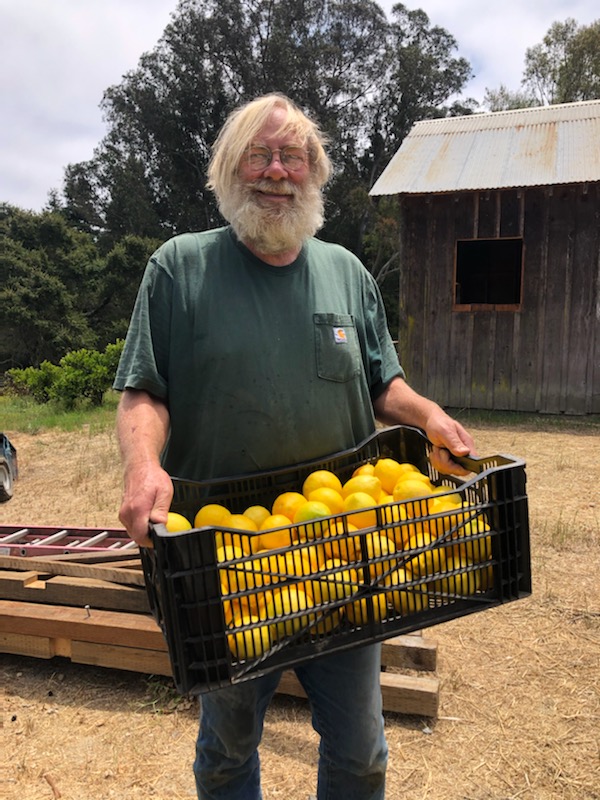
“When life gives you lemons, make….” Yada, yada, yada, you know how the saying goes. As pithy quips go, this sour cliche is not without its wisdom, but I find it’s hint of disdain for this versatile fruit distasteful, as though there’s something wrong with a lemon. The lemon is a gift! Just imagine if you had the misfortune to be born in Europe before the lemon was introduced from Southeast Asia. To a modern botanist, the Latin name for lemon is Citrus medica, but that reflects a consensus in the scientific community to use a highly modified form of the Latin language for taxonomic nomenclature; there wasn’t a word in classical Latin for lemon. Not only did the Romans not have the tomato, the potato, the bean, the squash, the chile pepper, or the corn plant, they didn’t have the lemon. When life finally did gave the Romans the lemon- via the discovery of a direct sea route from the southern Red Sea to India- the produce distributors of the Empire made MONEY. Lemons are great.
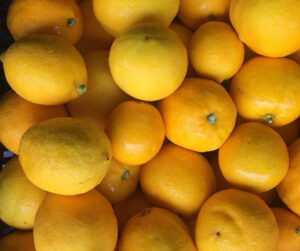 For the last ten years or so I’ve been planting lemons at my house. I started with some Meyer lemons, because they’re very popular and I enjoy their balance of sweet and sour. But the Meyer lemon is not a “true” lemon. Meyer was the fellow who encountered the “Meyer” lemon in the hinterlands of China, but make no mistake, it was the Chinese who developed the fruit by crossing the citron with a Mandarine orange/pummelo hybrid. Indeed, if you let a Meyer lemon hang on the tree for a long time, the fruit begins to pick up an orange cast to the skin which betrays the Mandarin heritage. The extra sweetness that the fully mature Meyer possesses is another hint that the fruit is not a true lemon. When life gives you Meyers, make dessert.
For the last ten years or so I’ve been planting lemons at my house. I started with some Meyer lemons, because they’re very popular and I enjoy their balance of sweet and sour. But the Meyer lemon is not a “true” lemon. Meyer was the fellow who encountered the “Meyer” lemon in the hinterlands of China, but make no mistake, it was the Chinese who developed the fruit by crossing the citron with a Mandarine orange/pummelo hybrid. Indeed, if you let a Meyer lemon hang on the tree for a long time, the fruit begins to pick up an orange cast to the skin which betrays the Mandarin heritage. The extra sweetness that the fully mature Meyer possesses is another hint that the fruit is not a true lemon. When life gives you Meyers, make dessert.
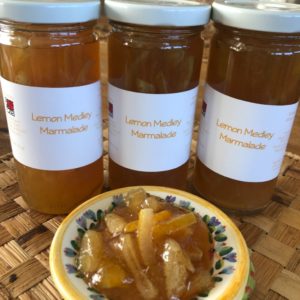 But as popular as the Meyer has become, the true lemon still has its fans. There is a bitterness to a true lemon that adds an attractive element of complexity to many dishes that the Meyer can’t match. When I saw how well the Meyer lemons did on the south facing slope of the field below my house I decided to diversify my little grove with a number of different “true” lemons. I planted Eureka lemons, Lisbon lemons, Femminello lemons, and a Santa Teresa lemon or two. Unfortunately, I didn’t keep the names straight, so I have a small lemon zoo of unnamed varieties. I guess you could say that when life sold me lemons I paid for the young trees but I didn’t pay attention. At least I’m having fun trying to rediscover the names of the plants I’m cultivating and when I gave Happy Girl Kitchen 300 pounds of mixed up lemons they made Lemon Medley Marmalade.
But as popular as the Meyer has become, the true lemon still has its fans. There is a bitterness to a true lemon that adds an attractive element of complexity to many dishes that the Meyer can’t match. When I saw how well the Meyer lemons did on the south facing slope of the field below my house I decided to diversify my little grove with a number of different “true” lemons. I planted Eureka lemons, Lisbon lemons, Femminello lemons, and a Santa Teresa lemon or two. Unfortunately, I didn’t keep the names straight, so I have a small lemon zoo of unnamed varieties. I guess you could say that when life sold me lemons I paid for the young trees but I didn’t pay attention. At least I’m having fun trying to rediscover the names of the plants I’m cultivating and when I gave Happy Girl Kitchen 300 pounds of mixed up lemons they made Lemon Medley Marmalade.
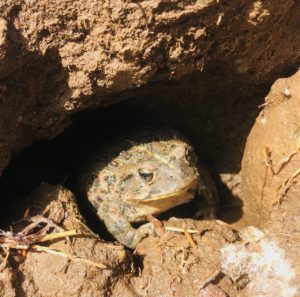 Today I spent the morning watering my citrus since it appears like we’re not going to get enough rain. I was also weeding around the base of the trees and getting ready to fertilize the crop. I use a special OMRI approved organic fertilizer twice a year, and I also toss on a handful of seaweed meal. Seaweed has a rich blend of trace elements and minerals which help the plant create interesting flavors. As I dug around the trees I unfortunately unearthed a drowsy toad. He ( or she or they) did not look all that happy to be disturbed, but lucklily wasn’t harmed. I thanked the creature for eating flies and mosquitoes and let it go back to sleep in the mud. When life gave the toad a lemon tree it made a home.
Today I spent the morning watering my citrus since it appears like we’re not going to get enough rain. I was also weeding around the base of the trees and getting ready to fertilize the crop. I use a special OMRI approved organic fertilizer twice a year, and I also toss on a handful of seaweed meal. Seaweed has a rich blend of trace elements and minerals which help the plant create interesting flavors. As I dug around the trees I unfortunately unearthed a drowsy toad. He ( or she or they) did not look all that happy to be disturbed, but lucklily wasn’t harmed. I thanked the creature for eating flies and mosquitoes and let it go back to sleep in the mud. When life gave the toad a lemon tree it made a home.
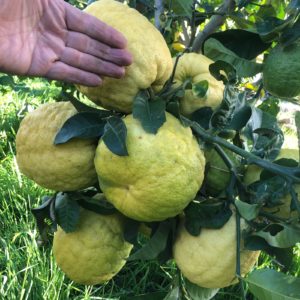
Cuban Shaddock
The different lemon varieties differ in size, shape, flavor, and season of yield. One tree is a standout, the fruits are enormous with an extremely thick rind. I spoke with the nursery where I’d purchased the trees. It turns out that my “lemon” was actually a Cuban Shaddock. For many years the Cuban Shaddock was used as a rootstock because of its vigor and disease resistance, and then a lemon scion was grafted on. A freeze had killed the lemon tree but the rootstock survived and now is fruiting. I’ve kept the Shaddock tree because it’s so entertaining. The Shaddock fruit is good too, but there’s not much of it inside all the pith. I also learned that the use of the Shaddock as a rootstock can sometimes make for lemons which have unusually thick peels, so nowadays the nursery has switched to other types of rootstock. So what do you do if life gives you a lemon with a thick rind? Make lemonade? Most of the lemony flavor in a lemon comes from the essential oils in the skin, nit from the juice. Here’s how I make lemonade:
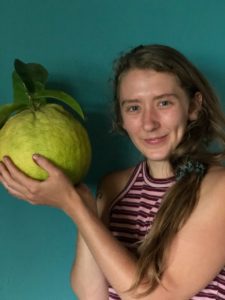
Eliza with a rather large lemon.
Use a vegetable peeler to slice off the colored part of the rind before you squeeze the lemons. I make a simple syrup by bringing two cups of water to a boil and then I add a cup of sugar and a generous handful of lemon peels. I let the lemon peels simmer in the sugar water for ten minutes of so, then I let the mixture cool before removing the skins. After I’ve juiced the lemons I add water and the lemony simple syrup until I find the balance I like. I find that most recipes make a lemonade that is far too sweet for my taste so I won’t tell you how much sugar to use, but I can assure you that the lemony syrup gives a real citrus punch to the drink. Sometimes for fun I’ll use several different kinds of citrus peels to jazz up the lemonade or I will make a batch of limoncello to use in a cocktail. Wintertime is citrus time on the farm, and this week life is giving you lemons. I hope you enjoy them as much as I do.
© 2021 Essay by Andy Griffin.
Photos by Starling Linden and Andy Griffin.


